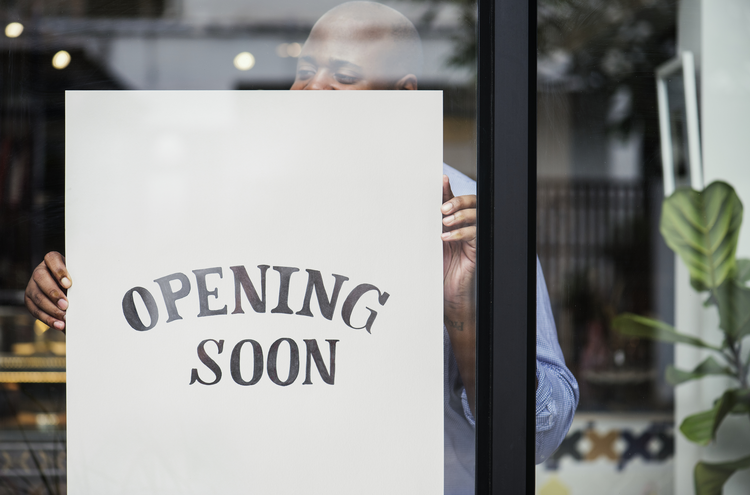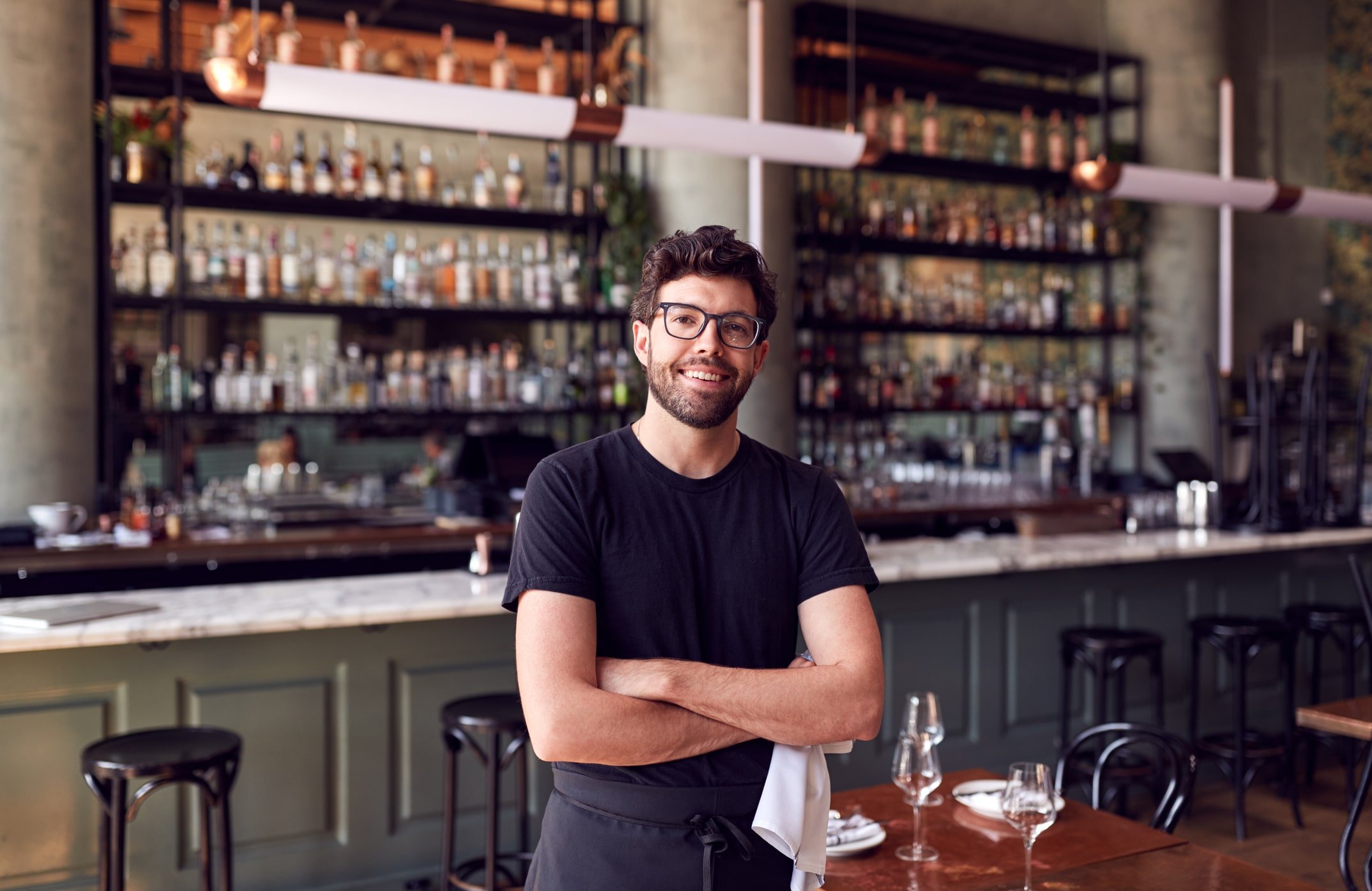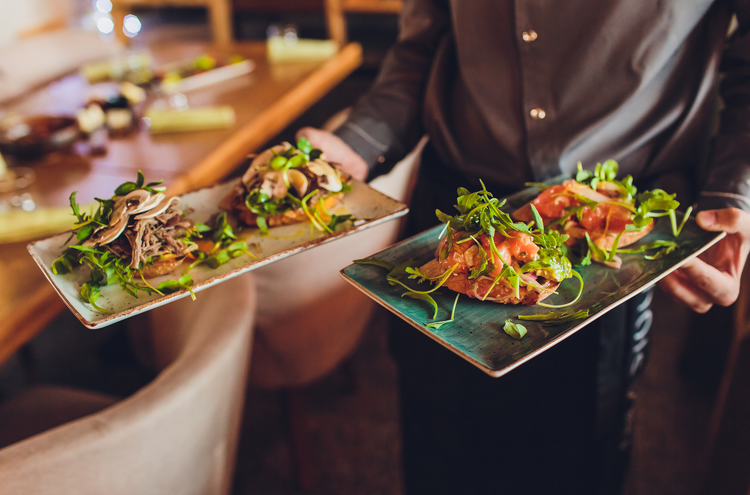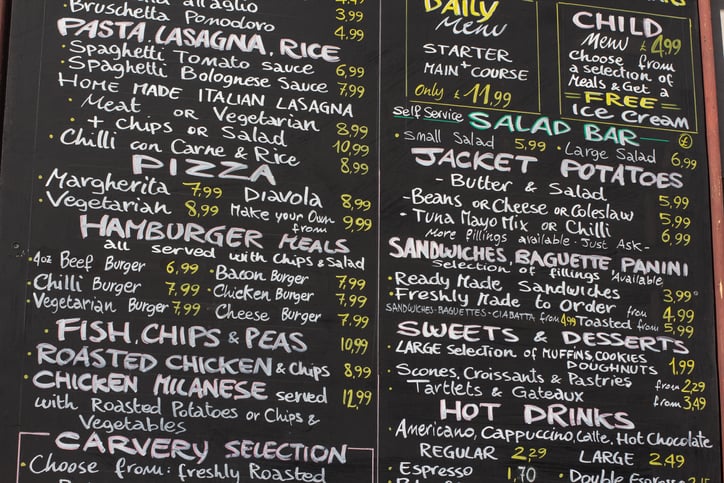This article was updated on June 20, 2024
How to open a restaurant: everything you need to know
Dreaming of a sizzling grill, a boisterous bar rail, or a candle-lit scene of culinary elegance? Envisioning the sights and sounds of a future restaurant is how every successful restaurateur begins. But beyond dreaming, starting a restaurant takes plenty of entrepreneurship, organization, and gusto.
That’s why we’ve created this easy-to-follow guide on how to open a restaurant.
From choosing a location to building your brand, this guide will provide the restaurant industry facts and experiences you need to make your delicious dreams a reality. If you are a business owner and want to open a successful restaurant, this blog post is for you.
A checklist for starting a restaurant
- Pick a concept for your food business
- Build your restaurant business plan
- Generate start-up capital
- Choose a space for your restaurant
- Obtain necessary licenses for your restaurant
- Order restaurant equipment
- Build your team of qualified restaurant staff
- Establish your digital presence
- Open your restaurant doors
Step 1: Build your new restaurant business plan
Before you leap into the world of hospitality entrepreneurship, you need a plan. Your restaurant business plan is a comprehensive document that details your vision and communicates precisely how your establishment will run and make a profit.
Business plans should include sections such as:
Securing Funding
Before opening your restaurant, it's crucial to secure adequate funding. This might involve personal savings, loans, or attracting investors. Consider creating a detailed business plan that outlines your financial projections and strategy to attract potential investors.
Financial analysis
Create a financial projection based on estimated cost and revenue. With extensive market research, identify your target market, local and national market conditions, and your overall business structure to display the sustainability and profit of your restaurant idea. The hospitality world is an over $600 billion industry, so creating a financially viable business is a must.
Managing Cash Flow
Effective cash flow management is essential to keep your restaurant operational. Track your income and expenses meticulously, and ensure you have enough liquidity to handle unexpected costs. Consider hiring an accountant or using accounting software to keep your finances in check.
Restaurant concept
Your restaurant concept should be reflected throughout your business through the style, branding, customer service style, and design. All of these details should be covered in your business plan. Whether you’re aiming to be a '50s-style greasy spoon or a local French patisserie, you should establish a distinct concept and consistent branding to make you instantly identifiable to your customers.
Restaurant menu
This is a restaurant after all. Detail the entirety of your menu with estimated ingredient cost, as well as projected pricing. Ensure each menu item compliments your restaurant concept. There’s always room to change and improve on an existing restaurant menu. Still, translate your culinary passion onto your food business plan and you’ll create an inspiring template for your upcoming restaurant.
Writing a quality business plan is an art of its own. Take your time, consult with legal experts and experienced restaurateurs, revise, and crunch the numbers. A business plan should be a solid foundation to build your restaurant on top of.
Keep in mind that your business plan will likely be read by anyone looking to invest a financial stake in your restaurant, so make sure it looks professional and displays precisely why your business is a good investment. Additionally, a well-written executive summary can be helpful to attract prospective investors.
Step 2: Generate start-up capital
How much does it cost to open a new restaurant? Restaurant For a business owner, food service startup costs can be quite intimidating. The actual number varies, but the average cost to start a restaurant is $275,000. On top of the cost to open, it’s typically recommended to have about a year’s worth of start-up capital on hand when you begin setting up your culinary adventure.
Start-up costs can include things like:
- Renovations
- Training fees
- Restaurant equipment and kitchen appliances
- Permits
- Down payments
- Payment systems
- Marketing and signage
While these restaurant start-up costs add up, it’s always possible to do more for less. Chris Dupont, a local chef in Birmingham, Alabama, was able to start his restaurant, Tau Poco, on a shoestring budget of $13,000. Oftentimes, ingenuity and passion can offset expenses—all it takes is a little creativity.
If you’re not using your own money as start-up capital, there are a few options to secure the necessary finances to set your restaurant in motion, including:
- Partnerships – High-income individuals may be looking to partner up and join you to accomplish your restaurant goals. Individual partnerships can help to add start-up cash to the venture, but be aware that financial partners typically request a say in what happens, so be ready to embrace collaboration if you take this route. Even if you’re working with someone you know, it always pays to put who gets a say in what is a contract.
- Bank loans - A standard way to finance any small business, a bank loan is a good option if you have a strong credit history and some collateral to back up the loan. The Small Business Administration is a federal government program that provides a variety of loans specifically for this purpose, including targeted loans to specific populations, such as veterans, minorities, and those with disabilities.
Once you’ve found your path to financing your restaurant idea, you can begin building your restaurant from the bottom up.
Step 3: Choose a space for your restaurant
When it comes to opening a restaurant, where you are is almost as important as who you are. Translation? Your restaurant’s location is just as vital to your success as the quality of your menu offerings and dining experience.
Before you can start serving customers, you’ll need to determine the best location to put down roots.
Choosing a location for your restaurant can come down to several decisive factors, including:
- Visibility – Call attention to yourself. The more visibility your location offers, the more opportunities for people to take notice. This goes double for areas with heavy foot traffic, where anyone strolling by could be your next walk-in.
- Competition – If you’re one of four Italian restaurants in a one-mile radius, you may want to reconsider your location. Every neighborhood may have its own culinary style, so make sure you offer something different than what’s already on your block. Your customers will appreciate the diversity of flavor.
- Price – Whether you’re leasing or buying, a lot comes down to the price tag of the building you plan to inhabit. Factor in possible zoning laws, utility costs, and costs for expansion when you’re deciding on your restaurant’s home.
- Size – How big is your overall operation? If your vision involves 100+ guests, try to find a space that has room to accommodate everyone and everything. That includes a kitchen with the necessary space, as well as stock rooms, closets, coolers, and storage areas.
Once you’ve decided on a location and space that fits your needs, you can begin to decorate, order, organize, and start setting up.
Create a layout that maximizes your space for both capacity and efficiency, and don’t be afraid to experiment. You never know what arrangement will be the most inspiring until you try it.
Step 4: Obtain the necessary licenses for your restaurant
You’ve made a plan, you’ve found the place, now it’s time to make sure you’ve got the greenlight from your local government to open up shop. Aside from the business license, you will also need a liquor license to sell alcoholic beverages. Restaurant license and permit laws vary from region to region, so be sure to check your local laws before you sell your first meal.
Here are just a few licenses and permits you may need to obtain:
- Business license
- Employer Identification Number
- Certificate of Occupancy
- Food service license
- Resale permit
- Building health permit
- Employee health permit
- Seller’s permit
- Liquor license
- Dumpster placement permit
This may be the most time-consuming step of all. Look into your local laws and the average time it takes to obtain these permits in your area so you can plan your grand opening accordingly.
Step 5: Order restaurant equipment
Depending on your restaurant, you will need to order the proper materials for your specific cuisine. Restaurant and kitchen equipment can be expensive, so strategy is key to selecting what you will be renting or buying. Start off by listing non-negotiables determined by what you will be serving on your menu. Next, determine occupancy and what furniture you will be needing to seat your guests. Remember to keep your budget aligned when picking out your respective materials.
Step 6: Build your team of qualified restaurant staff
Now that you have a home base, it’s time to staff up with the personnel that can bring it to life.
Your team might consist of:
- Servers
- Managers
- Support staff
- Bartenders
- Line-cooks
- Chefs
It takes a lot of dedicated individuals to run a new restaurant, and hiring can be a complicated process of its own. As Lindzi Shanks and Kat Connor of XO Marshmallow in Chicago, Illinois, say, “It’s not enough to get someone who is qualified. You need to find someone that believes in you and your vision in order to grow together.”
When putting together your team, consider the following to help make the process consistent and streamlined:
- Experience – While sometimes a fresh perspective from someone without past hospitality experience may be useful, oftentimes experience is the key component to deciding between applicants. Someone with years of restaurant experience may be able to acclimate quickly, provide outstanding customer service, and offer solutions to issues based on their previous knowledge.
- Soft skills – Those without specific restaurant experience may still possess the soft skills that make them prime candidates for hospitality work. Sociability, personal drive, strong work ethic, and flexibility are ideas at the center of all restaurant work, so keep these less obvious traits in mind as you look through potential hires.
- Personality and general fit – It might be difficult to define exactly what the atmosphere of your restaurant is, as a work environment, but you’ll know it when you see it. Your team will be spending a lot of time together, so it’s important to consider how each individual fits with the overall mission.
As a business owner, it’s recommended that you hire from within your community. A restaurant can be a gathering place for a neighborhood, and by intertwining locals with local businesses you’ll strengthen community bonds.
Once you’ve built your team, take a week or two before opening to train them and create systems everyone can understand easily, even during a lunch rush or last call.
Choosing the Right POS System
A reliable Point-of-Sale (POS) system is vital for smooth operations. It helps with order processing, payment handling, and inventory management. Research different POS systems and choose one that suits your restaurant's needs and budget.
Leveraging Technology for Efficiency
Modern technology can streamline various aspects of your restaurant, from reservations to customer feedback. Consider using restaurant management software to handle reservations, online ordering systems, and digital marketing tools to enhance customer engagement.
Step 7: Establish your digital presence
While signage is important, today, the quickest way to make a name for your restaurant is through a thoughtful digital presence that expresses who you are to a wider audience. Before establishing your digital presence, it is crucial to do market research and find your target customer.
A digital presence for a small restaurant can include:
Crafting a Marketing Plan
A well-thought-out marketing plan can significantly impact your restaurant's success. Identify your target audience, set marketing goals, and outline strategies to reach potential customers through various channels.
Utilizing Social Media
Social media is a powerful tool for restaurant marketing. Create engaging content, share behind-the-scenes looks at your restaurant, and interact with your audience to build a loyal customer base. Consider running promotions or contests to boost engagement.
From digital fliers to social media for your restaurant business, it’s important to use all the advertising tools at your disposal to market your new restaurant. Create a website, post pictures of renovations and menu items on social media, post an online event for your grand opening, and show off your branding and design for the world to see.
Promotional Tactics
Offer special deals, loyalty programs, or discounts to attract new customers and retain existing ones. Collaborate with local businesses or influencers to reach a broader audience and enhance your restaurant's visibility.
Digital advertising
While setting up the social media profiles for your new restaurant, investing a little budget in social media advertising such as Facebook ads or Google ads could be an effective restaurant marketing method to increase your presence to the targeted customers.
Networking with local businesses
Is your restaurant looking for organic produce and farm-fresh eggs? Contact a local farm and cross-promote your new relationship. Want to partner up with a local charity? Find one that’s already working in your area. There are plenty of ways to use your digital presence to expand your network and bring up other local businesses alongside you.
Direct interaction with your neighbors
Talk specifically to your neighbors and the greater community. Encourage them to offer suggestions and feedback, and let them know you’re listening. The more you engage with your fellow locals, the more your restaurant can shine as a pillar of the community. Nextdoor allows businesses to speak to neighbors directly, make announcements, offer deals, receive recommendations, and stay on the pulse of what’s happening in your neighborhood.
The digital marketing world not only offers a larger reach than ever before. It’s far more cost-effective than taking out physical ads and buying expensive signage. Use the tools of the digital age to your advantage and your restaurant opening will go off without a hitch.
Step 8: Open your restaurant doors
The permits are settled, the employees are trained, the food is prepped—it’s time to open your restaurant. Here are a few tips before you officially open up your doors:
- Have a soft opening – Before you put up your “grand opening” banner, invite friends, family, and trusted neighbors to come by for a soft opening (think of it as a kind of dress rehearsal for your official opening day). Let your staff invite their nearest and dearest as well so the entire team can have a practice run of your big opening day. Leave anonymous feedback forms on the tables so your first guests can help you work out the kinks for the big day.
- Offer a promotional event – Consider an online raffle for all your Nextdoor neighbors. With every new recommendation they post, they could be entered to win a free meal for two at your establishment. It’s a fun night out for your guests and the perfect way for you to introduce yourself and your restaurant to your new community.
Connect to your community with Nextdoor
By following the steps in this guide on how to open a restaurant, you’ll be ready to build the next amazing restaurant experience. The final step is to claim your Business Page on Nextdoor, the best way for local businesses to connect with their communities. At Nextdoor, it’s all about the neighborhood. Establish your brand presence with a free Business Page so your neighbors can get to know you before they walk through your door.








